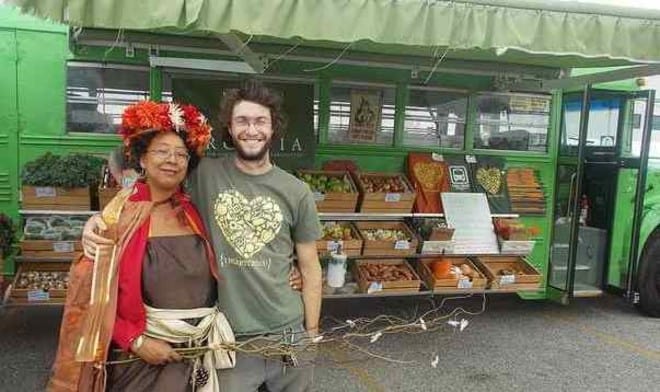Pamela Hess, executive director of the Arcadia Center for Sustainable Food and Agriculture, affectionately refers to the organization’s Mobile Market, a 28-foot rolling farmstand, as a “big crazy hippie bus.” The market, a school bus that’s been painted green and outfitted with an awning and food storage and refrigerators, brings a complete farmers’ market experience to areas of Washington, D.C., and environs that otherwise lack access to quality fresh food for residents.
In 2013, Arcadia’s farm on wheels did some $66,000 in business over 90 market days, a figure that Hess says pales in comparison to D.C. markets that bring in $50,000 in a weekend. But, she says, the real benefit is harder to gauge: “This means people don’t have to take three buses across town to spend $2.89 on a pound of apples. The scale is smaller, but the impact is huge.” The market stops at nine neighborhoods—six in Washington, two in Virginia, and one in Maryland—setting up shop in parking lots of hospitals, senior living residences, and corner stores. It’s stocked with a complete diet: meat, milk, cheese, fruits, vegetables, artisanal breads, yogurt, granola, honey, and herbs, and comes straight from 11 or 12 farms within a 100-mile radius. Benjamin Bartley, the Mobile Market’s director and driver, makes repeated visits to the market’s cold storage and headquarters for more supplies because he frequently sells out—often at every stop.
“Because we’re picking it up directly from the farmers, and because we’re buying what’s in season and in abundance, the food is incredible,” says Hess. “I’ve never had better food at a farmers’ market. Customers here are asking the same questions as they do at other markets, and it’s gratifying to be able to tell them where the food came from and, yes, it’s sustainable and local.” In addition, it means farmers can sell more of their crop than if they were bringing it all to markets themselves, and they, in turn, have an incentive to calculate how much they can sell to Arcadia, and at what prices. Costs are low, and savings are passed along to customers. Any risk is taken on by Arcadia as middleman, but there hasn’t been much, with sales figures up an impressive 50 percent over 2012.
Arcadia welcomes EBT cards and vouchers, but unlike other farmers’ markets that accept those means of payment, the Mobile Market matches the value of produce and protein purchases, up to $10. So a customer who spends $10 on fruits and vegetables and $10 on meats, cheeses, and eggs will go home with $20 worth of each of those.
The risk of unfamiliarity with any of the produce is minimized by the presence of JuJu Harris, Arcadia’s culinary educator and SNAP outreach coordinator, who is always on hand conducting cooking demonstrations and providing nutrition information.
On Tuesdays in spring and autumn, the bus visits schools to give students a chance to take part in activities that introduce them to sustainable agriculture, eating locally and seasonally, and meal preparation.
Future plans for the Mobile Market including expanding to year-round market days from the current May to late October season. Hess says she’d like to find the funds to get another market on the road, to be able to reach more neighborhoods more frequently. In the long run, she’d like to obviate the need for the Mobile Market. After seeding a demand for fresh, healthy local food and building up a substantial clientele, says Hess, she and her colleagues will approach corner and grocery stores with a couple of years’ worth of numbers presenting those as potential customers for the businesses.
“We will provide you with the food, and we will provide you with the customers, and we will support you every way we can,” says Hess, envisioning what she’ll say to these hypothetical stores, “and then we’ll move on to another neighborhood. That’s our master plan. We’re plugging an important gap, hoping to build market demand and helping usher in a permanent solution to the lack of fresh food in those neighborhoods.”







